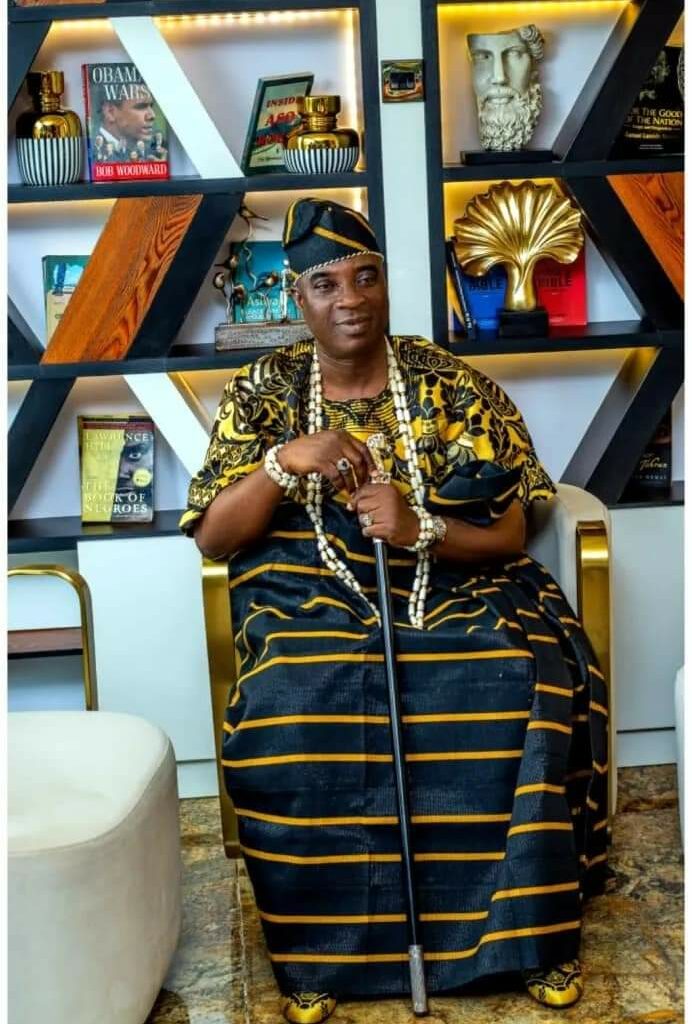He is as prolific and versatile in his creative output as he is in various other aspects of life – including his marital life and his brood of offspring.
K1 the Ultimate is certainly not a man who believes in half-measures. His is a grass-to-grace, rags-to-riches story testifying to the triumph of the human spirit against seemingly insurmountable odds, thanks to a combination of talent, hard work, consistency and steely determination. He is indeed a go-getter; in the course of his 66 years of life, he has gone far, and gotten much. And he shows no signs of slowing down, let alone stopping, his remarkable musical and entrepreneurial odyssey anytime soon.
Also known as KWAM 1 (short for King Wasiu Ayinde Marshall), the singer, originally named Wasiu Ayinde Adewale Olasunkanmi Omogbolahan Anifowoshe, has over the years established himself as a titan in the world of Fuji music, as well as positioned the genre itself as a unique cultural statement as far as Nigerian and global music is concerned. Thanks to his creative footprints in the fuji pantheon, K1 is often mentioned in many knowledgeable quarters in the same breath as such all-time greats as his late mentor, the legendary Alhaji Sikiru Ayinde Barrister, Kollington Ayinla, and others both living and dead. His work has also provided an inspiration for the careers of both his contemporaries and successive generations of Fuji artistes.
In the process, he has staked his claim to be mentioned in the annals of influential figures and ambassadors of Yoruba culture. And not just an ambassador (a status on account of which he is often referred to as the undisputed King of Fuji Music) but in fact, a custodian of sorts.
It is in recognition of this latter role (of a custodian of his people’s culture, identity and heritage) that K1 has over the years received multiple honours – including cultural awards and chieftaincy titles. For many years, he has been the proud holder of the title, Maiyegun of Yorubaland, which was bestowed on him in January 2020 by the immediate past Alaafin of Oyo, His Royal Majesty Oba Lamidi Adeyemi (now deceased), making him the first-ever holder of that title. His other chieftaincy titles include the Oluomo of Lagos (invested on him back in 1999 by His Royal Majesty, Oba Adeyinka Oyekan, the late Oba of Lagos); the Badabarawu of Ogijo (installed in 1985); and the Ekerin Amuludun of Ibadanland (installed in 1986). In recognition of his services in promoting the Fuji genre within and beyond the shores of Nigeria, and promoting the country’s image as a global cultural powerhouse, he was presented with the national award of Member of the Order of the Niger (MON) by Nigeria’s immediate past President, Muhammad Buhari on October 11, 2022.
To further cement his status as a custodian of culture, and the esteem in which he is held not only by his numerous fans across the globe, but by the pillars of traditional Yoruba society as well, K1 de Ultimate was, only a few days ago, invested with the prestigious title of Olori Omooba Akile Ijebu by His Royal Majesty, Oba (Dr.) Sikiru Kayode Adetona, Ogbagba Agbotewole II, the Awujale of Ijebuland.
The remarkable thing about K1’s attaining this feat, beside the fact that it ushers him into a rarefied world (indeed into the sphere of traditional nobility, if not royalty) is the sheer size of the metaphorical shoes into which he has now stepped – talking about the towering pedigree of the previous holder of that title. Until his recent death at the age of 89, Otunba Michael Olasubomi Balogun was one of Nigeria’s wealthiest men. Founder and long-time Chairman of one of Nigeria’s leading financial services groups, First City Merchant Bank (FCMB), Balogun was a direct descendant of Oba Tunwase of Ijebu-Ode. Apart from being the Olori Omooba Akile Ijebu, he also held the title of Asiwaju of Ijebu Christians. His formidable standing as a business mogul of global dimensions was matched only by the scope and reach of his philanthropy.
The ascendancy of King Wasiu Ayinde Marshall and his rise in high society reflects the evolution of the musical genre of which is has been such a leading exponent. Apart from helping to bring the genre from the margins of Nigerian popular music to its mainstream, he also popularized a brand of the genre known as Talazo fuji. Based on the work of his mentor – the aforementioned Alhaji Sikiru Ayinde Barrister – Talazo has in recent years enjoyed some level of cross-over appeal across age groups, as well as ethnic and social backgrounds. A musical genre wholly indigenous to the Yoruba ethnic nationality of southwestern Nigeria, Fuji initially arose from the improvisational ‘wéré’ music, also known as ajísari (meaning “waking up for sari”). Sari here is a reference to the call used to awake Muslims before dawn during the holy Ramadan fasting season. It was the illustrious Alhaji Sikiru Ayinde Barrister, a devout Muslim himself, who popularized ‘wéré’ music during the 1950s and 60s. According to legend, the name ‘Fuji’ was coined by Barrister on a whim; on one of his foreign trips, he saw a poster at an airport advertising Mount Fuji, the highest peak in Japan. He liked the name, and decided to give it to that pulsating musical expression.
Over the years, Fuji has undergone a tremendous transformation with the emergence of various artistes and groups, especially during the 1960s. In response to critics who dismissed Fuji, at the time, as ‘primitive music’ unsuitable for polite company, Barrister described the the genre as a combination of sákárà, Apala, jùjú, Aró, Afrobeat, gudugudu and some elements of highlife. He went on to popularize fújì by taking it all over the world – and in the process paved the way for successors such as K1 de Ultimate to embark on similar tours abroad. Others who burst into the limelight on the coat-tails of Barrister between the 1970s and ’80s were the likes of Fatai Adio, Saura Alhaji, Rahimi Ayinde (Bokote), Ramoni Akanni, Love Azeez, Waidi Akangbe, Sikiru Olawoyin, Agbada Owo, Iyanda Sawaba, Ejire Shadua, Wahabi Ilori, Wasiu Ayinde Marshall, Suleiman Adigun, Sakaniyau Ejire, and Wasiu Ayinla. And as time went on, each artiste developed and introduced his unique style of fújì music.
Perhaps as a reflection of its ‘were’ and Islamic origins, Fuji has been disproportionately dominated by male artists. But a number of female artists have developed fújì-related styles – (notably the Islamic and wákà styles). These styles emerged in the late 1950s and were originally performed by women vocalists for Islamic events such as weddings, and during celebrations for pilgrims returning from pilgrimage in Mecca. Since the 1980s, however, a number of Muslim women vocalists have established their own bands, which share instrumental similarises to regular fújì bands – though their subject matters may differ, thanks to religious sensitivities concerning the place of women.
Today, thanks to the influence of exponents like K1 de Ultimate, Fuji music has continued to attract the attention and patronage of younger and younger audiences across the nation and beyond. At the dawn of the 21st century, many popular and successful fújì artists have emerged. But by far the most recognizable names – the elite group, if you like – among Fuji artistes, apart from K1 de Ultimate, are the likes of Abass Akande Obesere, Wasiu Alabi Pasuma (Oganla Fuji), and King Saheed Osupa. But the undisputed King of Fuji music, King Wasiu Ayinde Marshall (aka KWAM 1, the Maiyegun of Yorubaland, and now the Olori Omooba Akile Ijebu) towers over them all.
K1’s ascendancy also reflects the value of consistency. Born in 1957, the young Wasiu discovered his interest in music at a tender age. Against the initial opposition of his parents, he pursued his passion with single-minded determination and vigour – so that by the time he turned 15, he had begun to prove his mettle by winning local musical competitions. His first life-changing break came when he joined Barrister’s band (known as the Supreme Fuji Commanders) in 1975. So influential was Barrister to the development of the young and impressionable Wasiu that the boy later adopted Barrister’s name ‘Ayinde’ as his own.
After leaving the Supreme Fuji Commanders in 1978 to form his own group, Wasiu Ayinde and his Fuji Revolution, he released his first album, ‘Iba’ in 1980 (which features the well-received special track, ‘Abode Mecca’). He followed this up in 1984:with ‘Talazo ’84’ (reputed by many to be his most successful album yet). As his fame grew on the strength of these two albums and other special singles, K1 began embarking on tours within and beyond the shores of Nigeria – notably to Europe and North America, in company of his group, known as the Talazo Band.
Till date, his hectic schedule of local and international tours and engagements shows no signs of abating.
Naturally, a career defined by such a combination of virtuosity and diligence is bound to reap accolades and widespread recognition especially in the entertainment industry – and that has been the case with K1 the Ultimate. His plethora of awards include the Golden Mercury of Africa title (presented in 1986), among many others. K1 is also the recipient of an honorary degree, Doctor Honoris Causa of Music (presented by St. John’s University at Bakersfield, California, USA in 1989). In 2014, he was presented with a Lifetime Achievement Award by City People Magazine.
Not bad for a boy whose parents did not envisage a musical career for him, and certainly could not, at the time, have forseen the lofty heights to which he’d reach on the wings of his talent and his mastery of his craft; his determination to succeed in life against the odds; his faith in his divinely-ordained destiny; his generosity of spirit and record of blazing the trail for others coming behind him; the reservoir of goodwill he has accumulated over the years from people, communities, groups, institutions and interests from every possible background; and his commitment to project the richness and profundity of the culture of the Yoruba ethnic nationality through his art.
As he prepares to assume the duties of his new status as the Olori Omooba Akile Ijebu, K1 de Ultimate can be expected to bring to his new role the same combination of attributes that have brought him this far, and to invest that office with the same aura of majesty and gravitas that his precessor, Otunba Subomi Balogun had given it.
For the people of Ijebuland in particular, and for the Yoruba race in general (a people for whom the arts, as intangible as they may appear, are as vital to the sustenance of life in all its nuances as the more existential human concerns), the investiture of a performer such as K1 de Ultimate into the pantheon of custodians of culture, tradition and heritage is a continuation of an age-long tradition. And for his teeming fans and admirers, it is a vindication of the Biblical truism that a man who is diligent in his work will stand before kings – especially if he already is a King of sorts.
King of Fuji music, that is.






